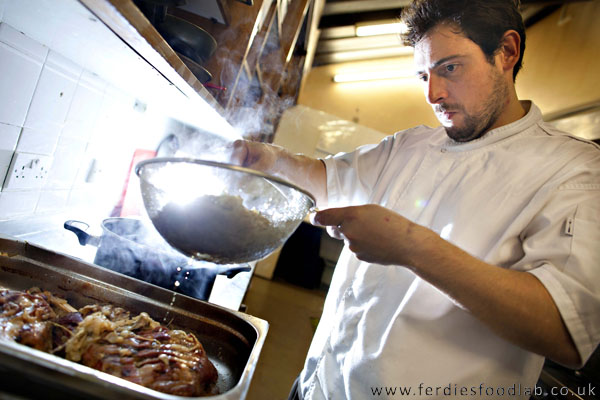Oven Temperature Chart - Centigrade - Farenheit
Gas Mark Conversion Table
Gas Mark Conversion Table
| Fahrenheit | Celcius | Gas Mark | ~°C |
| 212°F | 100°C | - | 100°C |
| 230°F | 110°C | 1/4 | 110°C |
| 250°F | 120°C | 1/2 | 120°C |
| 275°F | 135°C | 1 | 135°C |
| 300°F | 149°C | 2 | 150°C |
| 325°F | 162°C | 3 | 160°C |
| 350°F | 176°C | 4 | 175°C |
| 375°F | 190°C | 5 | 190°C |
| 400°F | 204°C | 6 | 205°C |
| 425°F | 218°C | 7 | 220°C |
| 450°F | 232°C | 8 | 230°C |
| 475°F | 246°C | 9 | 245°C |
| 500°F | 260°C | 10 | 260°C |
Meat Doneness Temperatures - How well done is my steak / joint?
| bleu | rare | med-rare | medium | med-well | well | |
| Beef | 45°C | 50°C | 55°C | 60°C | 65°C | 70°C |
| Rose Veal | - | - | 55°C | 60°C | 65°C | 70°C |
| Venison | 45°C | 50°C | 55°C | 60°C | 65°C | 70°C |
| Duck | - | - | 55°C | 60°C | 65°C | 70°C |
| Lamb | - | 50°C | 55°C | 60°C | 65°C | 70°C |
| Pork | - | - | - | 60-65°C | 65-70°C | 72°C |
| Poultry breast | - | - | - | - | - | 72°C |
| Poultry thigh | - | - | - | - | - | 77°C |
The simplest way to tell how well done a steak or a chicken breast is to press it with your finger. The more it resists your prod, the more cooked it is. If it feels pretty solid it's cooked through. A rare steak shouldn't offer much more resistance than a raw steak!
More here!
Rice / Grain vs Liquid - Ratios for Cooking
| Ratio(D:W) | Dry Weight (D) | Water / Juice (W) | Vinegar | Sugar | Salt | Cooked(g) | |
| Semolina (grainular finish) |
1:1.25 | 250g | ~315g | - | - | 2g | - |
| Couscous | 1:1.25 | 250g | ~315g | - | - | 2g | - |
| Barley Couscous | 1:1.75 | 250g | ~440g | - | - | 2g | - |
| Rice Jasmin | 1:1.6 | 250g | 400g | - | - | 2g | - |
| Rice Sticky | 1:1 | 250g | 250g | - | - | 2g | - |
| Rice Long | 1:1.7 | 250g | 425g | - | - | 2g | - |
| Rice Basmati | 1:1.7 | 250g | 400g | - | - | 2g | - |
| Rice Arborio | 1:1.65 | 250g | 375g | - | - | 2g | 570g |
| Rice Paella | 1:1.5 | 250g | 375g | - | - | 2g | - |
| Rice Sushi White Harder | 1:1.25 | 250g | ~315g | 50g | 25g | 1.5g | ~625g |
| Rice Sushi White Softer | 1:1.35 | 250g | ~340g | 50g | 25g | 1.5g | ~625g |
| Rice Sushi Brown H (Genmai) | 1:1.7 | 250g | 425g | 38g | 19g | 1g | - |
| Rice Sushi Brown S (Genmai) | 1:1.9 | 250g | 475g | 38g | 19g | 1g | - |
| Rice Black | 1:2 | 250g | 500g | - | 2g | - | |
| Rice Pudding | 1:6 | 250g | 3L (milk) | - | 250g | 3g | - |
| Quinoa | 1:2 (vol) | 250g | - | - | - | - | - |
| Semolina (smooth finish) |
1:6 | 250g | 3L (milk) | - | 250g | 1g | - |
| Polenta (to add) | - | 250g | - | - | - | - | - |
Note: the vinegar in sushi rice isn't included in the ratio since it's added after cooking the rice.
Rice Quantities for Different Sushi Types
| Format | Name | Pieces | Nori | Rice |
| Half Size Roll | Hosomaki-zushi | 6 | 1/2 | 75g |
| Full Size Roll | Futomaki-zushi | 6-8 | 1 | 150g |
| Inside Out Roll | Uramaki-zushi | 6 | 1/2 | 125g |
| Battleship | Gunkan maki-zushi |
1 | 2x13cm strip |
25g |
| Topped Rice | Nigiri-zushi | 1 | - | 25g |
| Tofu Pouch | Inari-zushi | 1 | - | 50g |
| Cones | Temaki-zushi | 1 | 1/2 or 1/4 | 30g/15g |
Nori sheets measure 19x20cm (7.5x8 inch)
NB: For half size cut across the length, leaving 2x 19x10 (instead of 20x9.5cm)
When handling rice, have a bowl of handling liquid - a mix of 50/50 water/sushi vinegar at hand:
- This will keep your hands from getting covered in rice - messy business!!
- It also has an anti bacterial effect - very important when handling rice.
Rice Cooker Table - Generic
| Rice in cups | Rice in g | Water Lev + rice | Serves | ~Cook time | Final Weight |
| 2 | 300g | 2 cup mark | 3-4 | 42 min | 750g |
| 4 | 600g | 4 cup mark | 5-6 | 46 min | 1.5kg |
| 6 | 900g | 6 cup mark | 8-10 | 50 min | 2.25kg |
| 8 | 1200g | 8 cup mark | 13-14 | 55 min | 3kg |
| 10 | 1500g | 10 cup mark | 16-18 | 60 min | 3.75kg |
Sugar Cooking Stages - Candy Making & Jam - Sugar Work
| Black Caramel | - | - | 205°C |
| Dark Caramel | - | - | 188-190°C |
| Spun Sugar | - | - | 180-182°C |
| Caramel | 174°C | - | 170°C |
| Hard Crack | 154°C | 150°C | 149-154°C |
| Soft Crack | 138°C | 134°C | 132-143°C |
| Hard Ball | 122°C | 125°C | 121-130°C |
| Firm Ball | - | - | 118-121°C |
| Soft Ball | 116°C | 116-118°C | 113-116°C |
| Jam | 104°C | - | - |
| Sterilise | 82-85°C | - | - |
| Thermo | LCB | McGee |
When we make paraline sugar spears, we take the caramel up to 170°C then it drop to 150-155°C before dipping the nut in the caramel and hanging it.
Stock Syrup Viscosity / Thickness
| Light | 250g sugar 500g water |
| Medium | 250g sugar 250g water |
| Heavy | 250g sugar 225g water |
More to come . . .
Find this page on tab here!










